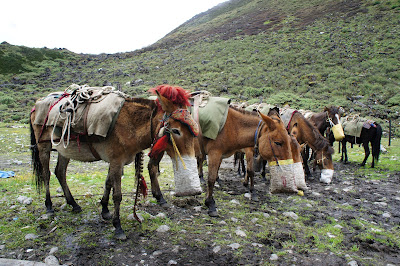 |
| a Brook Meanders Through The Lunana Higlands |
 |
| The Wind Driven Chelela Prayerflags |
Youngsters go to school dressed in their colorful national dresses. Grown ups leave for work attired pretty much the same way. In all government and places of worship and reverence, folks naturally don their national dress, not just out of respect and reverence but to continue a living cultural fabric that has endured the ages.
Infrastructure is under construction all around the kingdom. Yet the coming of globalization has had to take down the notes of localization, and as has often been the scenario, all imports become Bhutanized, with its own inimitable Bhutanese touch and feel.
 |
| View Atop Chelela Pass |
Beginning at the great Indian foothills at about 97m in the eastern dzongkhag (district) of Sarpang to as high as 3,800m above sea level at its highest motorable altitude. Mount Gangkhar Puensum, standing tall and unscaled at 7,570m in the northwestern part of the country in Gasa and Wangduephodrang dzongkhags is the highest peak. Buddhist beliefs in the sacredness of mountains remains a strong reason and a deterrent to why Bhutan's mountains have never been summited, with the exception of a few ill-fated expeditions. The sheer shift in altitude as one travels from the subtropical plains to the sub-alpine north provides for one of the richest flora and fauna and a drive, once accustomed to the literal twists and bends almost every couple of seconds or minutes, provides for a shifting climate and a view and a ride seldom dull.
 |
| a Calm Jade Lake in Lunana |
Still the present scenario, as far as the tourism sector
is concerned, is rather flat and numb. The kingdom’s natural, rugged, adventurous
and smooth landscapes from down in the plains up to the northern lands and
glaciers have been untapped. Most itineraries offer the same deal and meal, but
more pertinently, if the idea is to get potential travelers interested, then a
radical new approach is required; one befitting the kingdom’s rich flora, fauna,
culture, tradition and the changes about, along with untouched lands such as
the northern belts.
Keeping in mind the present scenario, there are
ample ways to market, brand and lure new visitors to the country. Some of the
lingering old stereotypical images of the country such as the division of summer
and winter as “Off Seasons” must be erased, together with the notion of US$200
a day tariff. This is where Adventure Roots will tailor itineraries as you like it- on or off the beaten track or path, just let us know and we'll work out a tailor made schedule that offers your more without taking the spontaneity... or the surprise!
 |
| A Highland Yak-Dog, Known as the Bjob |
 |
| A Fresh Creek Runs Through Lower Lunana |
 |
| The Highland Ponies |
*For The Spirited Traveler
**All Lunana Photographs Courtesy Karma Tshiteem, Sec, GNHC & All Chelela Photographs Courtesy Xochitl Rodriguez

No comments:
Post a Comment